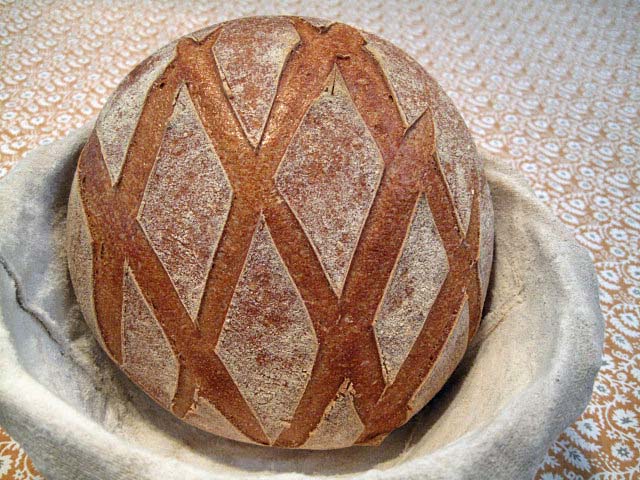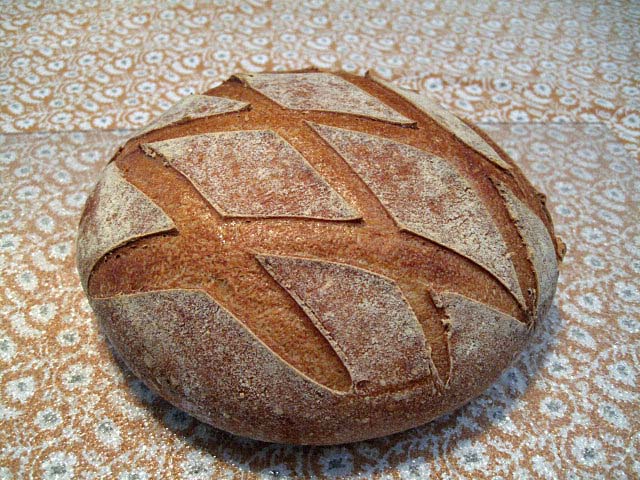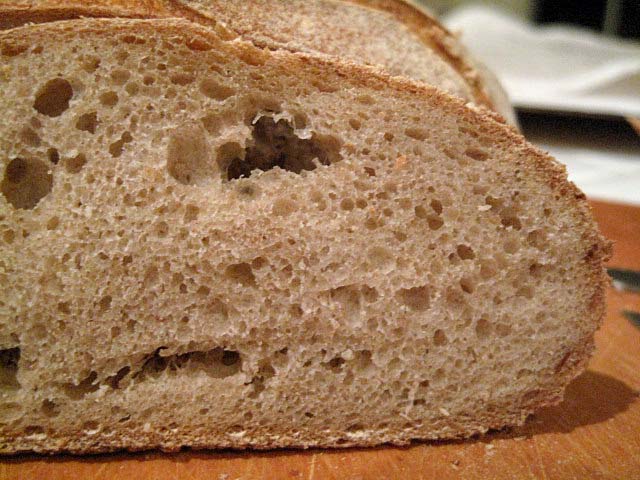
I have made miches from Peter Reinhart's BBA, from Daniel Leader's “Local Breads” and the Miche, “Pointe-à-Callière” from Jeffrey Hamelman's “Bread.” All were good breads. Reinhart's was the closest to the Pain Poilâne I remember from my single tasting in Paris some 25 years ago.
This weekend, I baked the miche from Michel Suas' “Advanced Bread and Pastry” for the first time. Suas references Pain Poilâne as the best known miche, but he does not say his formula is an attempt to replicate it. His “miche” is a 2 lb boule. This is smaller than my notion of a miche, but what do I know? I'll ask M. Suas the week after next when I'm at the SFBI for the Artisan II class and report back.
Suas' formula and procedures are quite unusual in several respects. It uses 3 builds and specifies a mixture of high-extraction, bread and medium rye flours. The final dough has 50% pre-fermented flour from the levain, and almost all the water comes from the 120% hydration levain. Even more remarkable is the very brief bulk fermentation of 15 minutes. I assume this works because of the very high percentage of pre-fermented flour. After shaping, the miche is retarded overnight before baking.
|
First levain feeding |
Wt. |
Baker's % |
|
High-extraction flour |
1 3/8 oz |
100 |
|
Water |
1 ¾ oz |
120 |
|
Salt |
1/8 tsp |
0.6 |
|
Starter (stiff) |
1/8 oz |
10 |
|
Total |
3 ¼ oz |
230.6 |
-
Mix all ingredients well with a DDT of 70ºF
-
Ferment 16 hrs at room temperature.
|
Levain formula |
Wt. |
Baker's % |
|
High-extraction flour |
8 1/4 oz |
100 |
|
Water |
9 7/8 oz |
120 |
|
Salt |
1/4 tsp |
0.6 |
|
First feeding |
3 1/4 oz |
40 |
|
Total |
21 5/8 oz |
260.6 |
-
Mix all ingredients well with a DDT of 70ºF
-
Ferment 8 hours at room temperature.
Note: I fermented at room temperature for 6 hours, then refrigerated overnight. I allowed the levain to warm up and ferment another 2 hours before mixing the final dough
|
Final dough formula |
Wt. |
Baker's % |
|
Bread flour |
5 5/8 oz |
60 |
|
High-extraction flour |
1 7/8 oz |
20 |
|
Medium rye flour |
1 7/8 oz |
20 |
|
Water |
7/8 oz |
10 |
|
Salt |
3/8 oz |
3.8 |
|
Levain |
21 5/8 oz |
230.6 |
|
Total |
21 5/8 oz |
344.4 |
Note on ingredients: I used "Organic Type 85" flour from Central Milling for the high-extraction flour, KAF Bread Flour and KAF Medium Rye flour.
Process
-
Mix water and Levain
-
Mix flours and salt. Add to water/levain mixture and mix to medium gluten development. (I mixed this dough in a Bosch Universal Plus for 3 minutes at first speed and 6 minutes at second speed.)
-
Transfer to a lightly oiled bowl and ferment for 15 minutes.
-
Pre-shape the dough into a light ball and rest it for 20-30 minutes.
-
Shape into a boule. Place it in a banneton and cover well with plastic or place in a food grade plastic bag.
-
Retard overnight in the refrigerator. (Suas specifies a temperature of 48ºF, actually.)
-
The next morning, pre-heat your oven to 500ºF with baking stone and steaming apparatus in place.
-
Pre-steam the oven. Transfer the miche to a peel. Score the miche. (Suas specifies a diamond pattern.) Transfer it to the baking stone. Stem the oven. Turn the oven down to 440ºF. (See Note, below.)
-
Bake for 45 to 50 minutes or until the internal temperature is 205ºF and the bottom gives a hollow sound when thumped. (Note: I baked this in a Lodge Combo Cooker – Convection bake for 20 minutes covered at 460ºF, covered then 25 minutes at 440ºF, uncovered.)
-
Transfer to a cooling rack and cool thoroughly before slicing.
Suas doesn't mention it, but most authors recommend waiting 12 to 24 hours before slicing this type of bread.

The miche

Miche crumb
I sliced and tasted the bread after it had cooled for about 4 hours. The crust was crunchy. The crumb was chewy. The aroma and flavor were unlike any bread I've ever tasted. It did have a mild sourdough tang, but the flavor was uniquely wonderful. It had some nuttiness I associate with wheat germ and sweetness I've only tasted before in some baguettes that have had a long, slow fermentation or were made with pâte fermentée. I assume the wonderful flavor can be credited to the combination of the "Type 85" flour and the unusual process commented on above.
I'm looking forward to baking some other miches using this flour. It's wonderful.
David
Submitted to YeastSpotting
- dmsnyder's Blog
- Log in or register to post comments
Just a great looking loaf David. The combo cooker is the perfect size for a 2 pound loaf.
Eric
You know, I think the combo cooker could handle a 3 lb or even a 3 1/2 lb loaf. There was lots of room around the edges of this Miche both when loaded and after it was baked.
I'm inclined to give it a try with a larger loaf.
David
That's a beautiful boule, David.
David
David,
What a pretty looking miche! You've done some really precise scoring on a perfectly proofed loaf. The results are oustanding! Can't wait to see the crumb shots.
Franko
I was pleased with how the scoring turned out. Thanks for the compliment!
David
David
Hello David, What an absolutely beautiful loaf you've made.
I love the perfect, diamond scoring.
SFBI should put you on the faculty!
Regards, breadsong
You are too kind.
David
I like the large diamonds. Is that rice flour on the raised surfaces?
50/50 mix of AP and rice flour in the banneton.
David
I tried this formula before, using the beer barm starter. Really liked the taste of that loaf, wasn't sure wether it was from the beer barm starter, or the process itself, will have to make it again using regular starter.
I've never made a true barm, so I can't comment on the flavor impact. I've made other miches using other flours, and I'm pretty sure the special flavor I got with this bread can be credited to the particular high-extraction flour I used. However, I plan on testing this by making some other breads with this flour. I'm thinking of the miche from BBA and the Miche, pointe-a-calliere from "Bread."
David
I want to hang it up for Holiday decoration, but I know it would be eaten right away! Looks and sounds delicious!
I believe a miche is anything from 2 lbs. up...a nice big round loaf, but what is it called if it's not round and weighs over, say 6 lbs. Hope you ask TSBI instructors!
Though smaller loaves would be better suited for the two at my home. I usually bake 2 lb loaves. I just like a good size loaf of bread.
The CC seems just right in circumferance but I'm sure about larger loves with a lot of oven spring...I've had very light loaves press against my lacloche and it has a very high ceiling.
Sylvia
Magnifique!! I wiche I had been there.
Now I can't wait to try the Central Milling Type 85.
Glenn
Try the Miche from BBA with the Organic Type 85. It should be wonderful. Not to be miched!
David
My miche seemed to perform well, and it looks and smells wonderful. Blog post to follow. Thanks.
Glenn
etc.
David
Hi David,
Do enjoy your pre-Christmas treat at SFBI, and I'm sure M Suas will be keen to answer your questions on this loaf. I'd just like to hang these post in front of the good people of TFL. These are the nearest equivalents I can ever imagine to "Pain Poilane", from Shiao-Ping:
http://www.thefreshloaf.com/node/16522/poil%C3%A2ne-inspired-process-dough-and-levain-de-p%C3%A2te
http://www.thefreshloaf.com/node/16848/t110-miche
Truly wonderful; would that authentic high extraction milled flour was easier to find!
BW
Andy
Absolutely perfect!
I've only made the BBA and Hamelman's, and prefer the latter - but your description of this one makes me want to try it in my next miche-adventure
loved the pattern on the surface.... truly beautiful!
Especially the decorative scoring. Just a lovely loaf to look at. My few attempts haven't had the nice crumb profile you managed.
Larry
Great-looking miche, David - that scoring is sensational.
Looking through your process, do I have it right that essentially there's no bulk proof before the shaping - only a final proof overnight, following which you bake it straight out of the fridge?
Cheers
Ross
Hi, Ross.
Thanks for the compliment!
Suas specifies a 15 minute bulk fermentation before shaping. He doesn't say a thing about proofing after retardation. I didn't follow his procedure exactly. See my notes.
After retardation, I let the loaf proof and used the poke test to assess readiness to bake. (The poked dough sprang back slowly.)
David
I've settled on a process that works well and suits my baking timeframe, and I now apply it to all my breads regardless of dough composition or recipe directions. ie: mix, autolyse, add salt and bulk proof 2 hours+ depending on ambient temp and dough appearance with hourly S&Fs, shape and retard overnight. Bake straight out of fridge next morning.
I'm keen to try this one, because I've been thinking for some time of varying my usual process to see what sort of difference it would make to the finished product. This recipe as you've described it is quite different from any Ive tried before, so I figure it's a good one to try, especially in light of your very favourable comments on the flavour.
Just one more quick question, if I may. When you do the poke test, do you watch for the dough to slowly spring all the way back so there is no indentation at all, or is some indentation permissable? I ask, because I have just had reason to deviate from my usual procedure, and ended up with a slightly underproofed loaf. I did a half-hearted poke test, but was overconfident and ignored the fact that it didn't spring all the way back. I'm guessing I should have waited until I could poke it and have it spring gradually back to erase all trace of an indentation, but am not 100% on this. Hence my question.
Cheers
Ross
The more advanced the proofing, the less the poked dough springs back. I generally bake when the dough no longer springs back completely, but this criterion does not apply to high-hydration doughs as well. They tend to spring back less.
David
Yes, that makes sense with high hydration doughs.
Going by my experience yesterday, then, the poke test is only an approximate indication of when a dough is properly proofed - or perhaps the fault lay with the interpreter. I guess you've got to try it out over time on different doughs to get a real feel for when the test says go and when whoa.
Cheers
R
Hello David:
Wow! Another "Masterpiece" . I bookmarked your post on my "long list" of Breads that I must learn how to make!
I have some questions: What does DDT means? Also "High-Extraction" flour? What is it and what do you use? Medium Rye flour?
I am sorry but I am still trying hard to learn the mystery of bread baking!
I am using the advices I read on the post to "try and try " again on the same bread until I can really do it well .I am proud to say that I had mastered some of it now.
Thanks, David.
mantana
DDT is "desired dough temperature."
High extraction flour means that some but not all of the bran and wheat germ is removed from the flour. (In reality, it is removed and some is put back.) I used "Organic Type 85 unbromated" flour from Central Milling. Ricky Giusto told Glenn this is close to the flour Lionel Poilâne used in his Miches.
Medium rye flour is whole grain rye milled to medium consistency - less coarse than pumpernickel, more fine than "fine."
Hope this helps.
David
Can KA Sir Lancelot Flour be used for the High Extraction Flour? Probably not, but that is what I have and cannot find high extraction flour locally.
What a wonderful bread, fashioned with such precision. And thank you for sharing your SFBI class experience with those of us who haven't had the pleasure. I have enjoyed baking with the Central Milling high extraction type 85 as well. The Giusto folks are wonderful and generous.
Joyful
Thanks so much for the quick reply. Love how the Miche came out.
Good Morning David:
Thank you for taking the time to answer my questions. It will be almost impossible at this time to get the same quality flour as yours in my neck of the wood. I will explore more in a bigger towns.( Roanoke doesn't have it either.)
In as much as I love my village, it is impossible to get "exotic" flours , pastry, or any fresh seafood. I love Penetone and was able to get one early in Nov. at Sam's werehouse in Roanoke. Now, there are none anywhere.
As a native Thai whose home is on the Tropical Island I am forever miss my fresh seafoods ,fruits and vegetables.sigh!
Now that I am addicted to Penetone, other fine Western pastries and unable to get it here, I got to learn how to make Penetone and others, sigh!
mantana
Hi David,
I find myself stumbling on your posts quite often.
a great looking and I'm sure great tasting bread.
We've become fixated on miche since one of local artisan bakeries has started supplying to local markets.
It's probably the huge Tom Cat in LIC or some other, but the bread reminds me so much of what I had in Europe in neighborhood shops. Especially the old city of Bilbao.
even though this is a rather old thread, perhaps you're still subscribed?
You baked in a Lodge combo. Therefore I assume you had no "steam apparatus"?
What is the "sift method" for DIY high extraction?
Thanks, Fritz
This bread was not baked in a Dutch oven. It was baked on a preheated baking stone. I cannot recall what steaming method I was using when I baked this bread. Currently, I use a 9" cast iron skillet filled with lava rocks. This is pre-heated for 45-60 minutes, along with the baking stone. The stone is on a rack in the middle of the oven. The skillet is on the lowest shelf. Right before baking, I fill a perforated pie tin with ice cubes and place it on top of the lava rocks. I generally remove the whole steaming apparatus 12-15 minutes into the bake.
Here is a photo of my steaming apparatus:
I don't know much about sifting WW to obtain "high extraction" flour. If you don't want to order ihigh extraction flour, I would use a mix of white and whole wheat flours. If you can order it, my favorite is the T85 replica from Central Milling. I am about 200 miles from their warehouse, so shipping is fast and not too costly.
And, FWIW, this is not my favorite miche formula. For my personal favorite, look at these two versions:
Miche from SFBI Artisan II - 2 kg
This miche is a hit!
Happy baking!
David
thanks David. cool method for steam. I've just been using a porcelain roasting pan with boiling water in it, but it obviously is a little weak. Does the cast iron rust or are you diligent to keep it clean?
I guess any lava rock from amazon would do the trick?
I just noticed that CM has 5lb bags of type 85. Didn't think I saw that when I looked years ago.
I'll check out the other 2 miche.
Ever done any bread with einkorn or farro piccolo ?